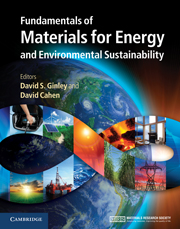Book contents
- Frontmatter
- Contents
- Contributors
- Preface
- Acknowledgments
- Part 1 Energy and the environment: the global landscape
- Part 2 Nonrenewable energy sources
- Part 3 Renewable energy sources
- 17 Solar energy overview
- 18 Direct solar energy conversion with photovoltaic devices
- 19 Future concepts for photovoltaic energy conversion
- 20 Concentrating and multijunction photovoltaics
- 21 Concentrating solar thermal power
- 22 Solar thermoelectrics: direct solar thermal energy conversion
- 23 Off-grid solar in the developing world
- 24 Principles of photosynthesis
- 25 Biofuels and biomaterials from microbes
- 26 Biofuels from cellulosic biomass via aqueous processing
- 27 Artificial photosynthesis for solar energy conversion
- 28 Engineering natural photosynthesis
- 29 Geothermal and ocean energy
- 30 Wind energy
- Part 4 Transportation
- Part 5 Energy efficiency
- Part 6 Energy storage, high-penetration renewables, and grid stabilization
- Summary
- Appendix A Thermodynamics
- Appendix B Electrochemistry
- Appendix C Units
- Index
- References
24 - Principles of photosynthesis
from Part 3 - Renewable energy sources
Published online by Cambridge University Press: 05 June 2012
- Frontmatter
- Contents
- Contributors
- Preface
- Acknowledgments
- Part 1 Energy and the environment: the global landscape
- Part 2 Nonrenewable energy sources
- Part 3 Renewable energy sources
- 17 Solar energy overview
- 18 Direct solar energy conversion with photovoltaic devices
- 19 Future concepts for photovoltaic energy conversion
- 20 Concentrating and multijunction photovoltaics
- 21 Concentrating solar thermal power
- 22 Solar thermoelectrics: direct solar thermal energy conversion
- 23 Off-grid solar in the developing world
- 24 Principles of photosynthesis
- 25 Biofuels and biomaterials from microbes
- 26 Biofuels from cellulosic biomass via aqueous processing
- 27 Artificial photosynthesis for solar energy conversion
- 28 Engineering natural photosynthesis
- 29 Geothermal and ocean energy
- 30 Wind energy
- Part 4 Transportation
- Part 5 Energy efficiency
- Part 6 Energy storage, high-penetration renewables, and grid stabilization
- Summary
- Appendix A Thermodynamics
- Appendix B Electrochemistry
- Appendix C Units
- Index
- References
Summary
Focus
Photosynthesis is the biological process that converts sunlight into chemical energy. It provides the basis for life on Earth and is the ultimate source of all fossil fuels and of the oxygen we breathe. The primary light reactions occur with high quantum yield and drive free-energy-demanding chemical reactions with unsurpassed efficiency. Coupling of photosynthesis to hydrogenases allows some organisms to evolve H2. Research into understanding and applying the molecular details and reaction mechanisms of the involved catalysts is well under way.
Synopsis
Life needs free energy. On our planet this free energy is mostly provided by the Sun. The sunlight is captured and converted into chemical energy by a process known as photosynthesis (from Greek, photo, “light,” and synthesis, “putting together”). This process occurs in plants and many bacteria. The “big bang” of evolution was the development of oxygenic photosynthesis. In this process sunlight is employed to split the abundant water into the molecular oxygen we breathe. The protons and electrons gained are employed by the organism within complex reaction sequences to reduce CO2 to carbohydrates. The widespread availability of the electron source water allowed oxygenic organisms to spread and diversify rapidly. The O2 produced was initially toxic for most species, but those which learned to cope with the emerging oxygen-rich atmosphere were able to gain additional energy by “burning” organic matter.
- Type
- Chapter
- Information
- Publisher: Cambridge University PressPrint publication year: 2011
References
- 1
- Cited by



